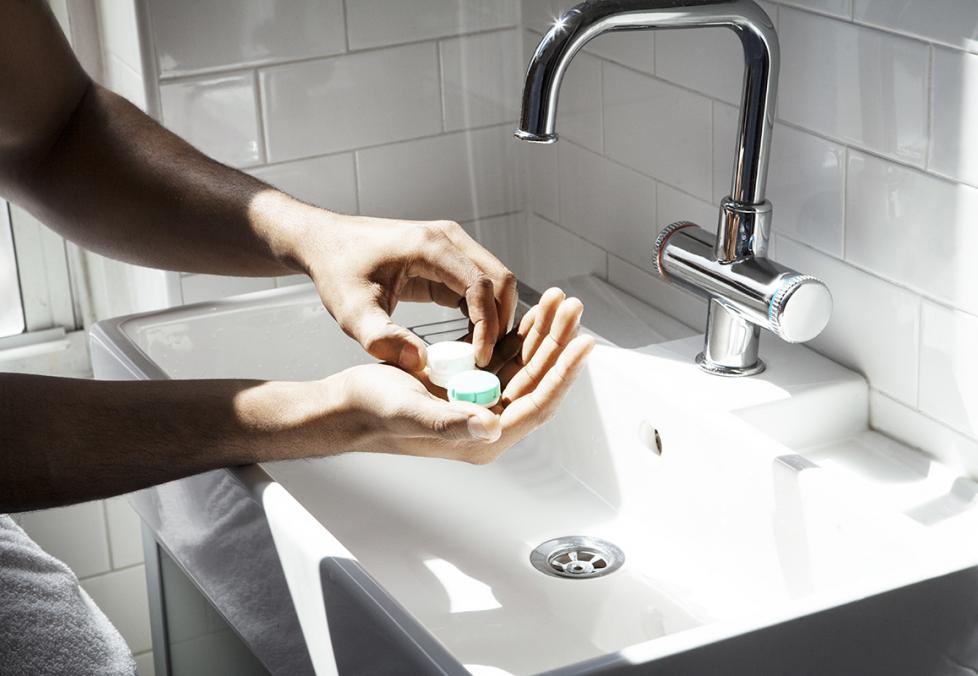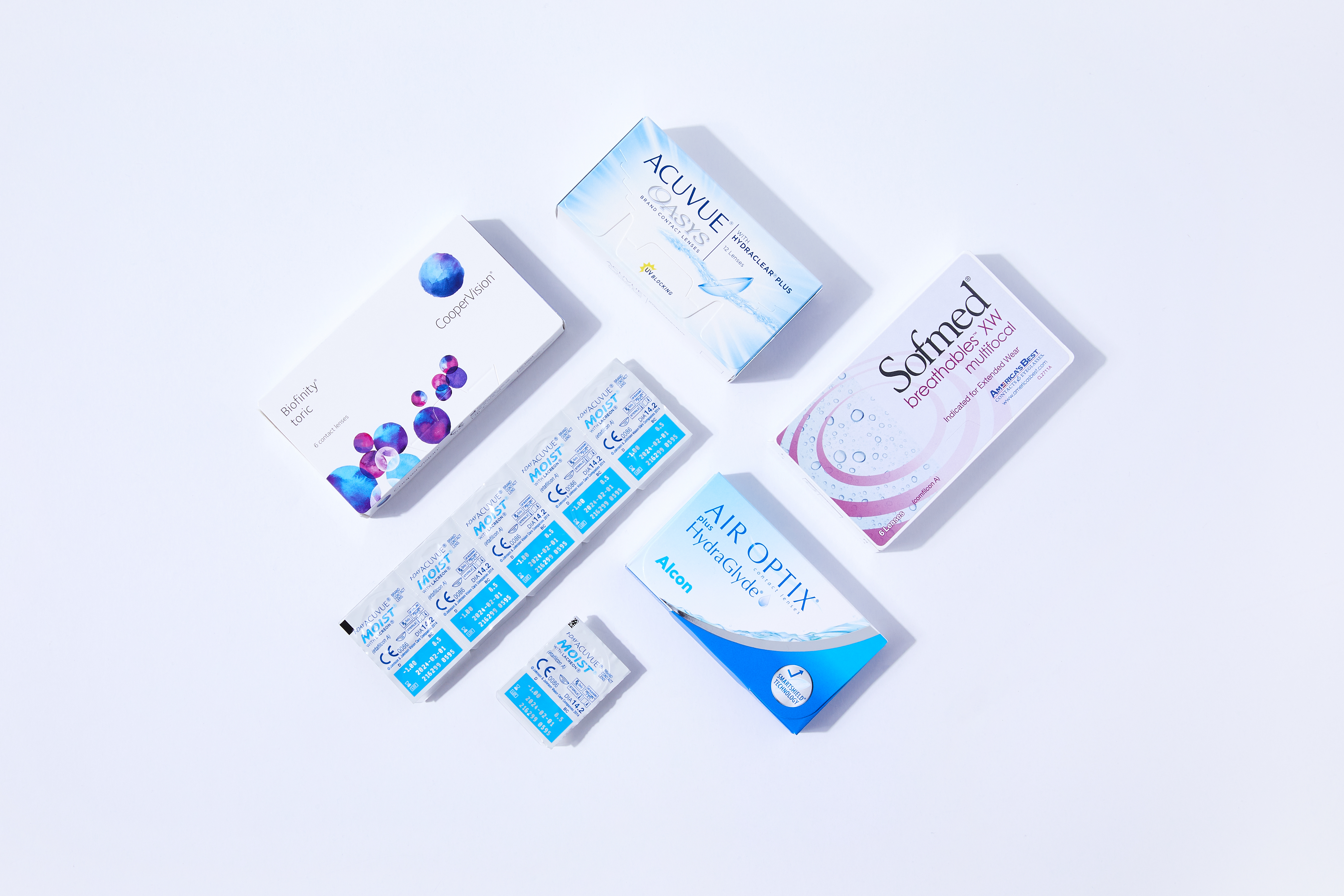
Treat your eyes to a free quality eye exam with our popular two-pair offer.
Everything you need to know to take care of your eyes — for life.
Poor contact lens hygiene can lead to major eye issues. Follow these contact lens care tips to keep your eyes healthy and your vision sharp.

One of the major selling points of contact lenses is their worry-free reputation. After all, you don’t have to worry about accidentally stepping on them or misplacing them like you do with eyeglasses. They’re not going to fly off your face while you’re riding a roller coaster. And you can wear nonprescription sunglasses to the beach over your contact lenses.
But with that carefree rep comes a dose of responsibility. “It’s important to learn how to take care of your contact lenses, to keep your eyes healthy and your vision clear,” says Madison Lessard, O.D., an optometrist who practices at America’s Best Contacts & Eyeglasses in Coral Springs, Florida.
Dr. Lessard notes that poor contact lens hygiene can lead to:
Fortunately, it’s not hard to avoid these contact lens complications. Just follow Dr. Lessard’s top contact lens safety tips.
Have questions about your vision or eye health? Your America’s Best optometrist is here to help! Find an exam time that fits your schedule.
The first step to finding the right contact lenses is to get a contact lens exam. During this appointment, your eye doctor will determine the right prescription, type of lens, and exact fit for your eyes.
This exam is so important that you won’t be able to purchase contact lenses without one.
“If the contact lens is too loose, it will slide around and be more difficult to get it out of the eye,” says Dr. Lessard. “And if it’s too tight, it can cut off oxygen and blood flow to the tissue around the front of the eye. That would cause dryness and irritation and problems down the road.”
Your America’s Best optometrist can make sure you’re getting the perfect fit and lens features that are right for your vision needs.

Beware of online sellers that don’t require a contact lens prescription. Selling nonprescription contact lenses online is illegal in the United States — even color contact lenses.
With a current, valid contact lens prescription, you can easily order lenses online at America’s Best. (Here’s how to get started.)
And be mindful of scams. Some contacts are marketed online as “one size fits all” — even though there’s no such thing for contact lenses, warns Dr. Lessard.
Once your doctor has sent you home with new contacts, it may take a week or two to get used to feeling them in your eyes, says Dr. Lessard. This is especially true if you’re wearing multifocal contact lenses for the first time. Try to be patient during this adjustment period, even if it feels a little weird.
A few things that help first-time contact lens wearers get used to their new “eyes”:
That being said, you shouldn’t be uncomfortable or in pain. Call your optometrist right away if your eyes are red, irritated, or tearing, or if it feels like the contact is moving around. They may want you to try a different size, brand, or type of contact.
Always wash your hands with soap and dry them with a clean, fresh towel before inserting or removing your contact lenses.
Your hands touch doorknobs, your cell phone, and other germy surfaces throughout the day. It’s easier than you think for bacteria to travel from your fingertip to your contact lens — and from your contact lens into your eye.
Ever heard of the “taco test”? Press play to learn this trick and other tips that will make you a pro at putting in and removing your new contact lenses:
Unless you wear daily contact lenses, you’ll need to clean your contacts every day to keep them free of dirt and bacteria.
To clean a contact lens:
“If you use your index finger, it might be a little bit too much force, and you could end up ripping the contact lens,” Dr. Lessard says.
Different types of contact lenses require different cleaning methods and solutions. Make sure you use the solution your eye doctor recommends.
A few more important steps:
Your case needs to be cleaned daily, too. With clean fingers, squirt the case with contact lens solution and rub the inside and outside of the case. Dry it with a clean towel or paper towel, or let it air-dry face down. Never use soap and water, says Dr. Lessard.
“If you’re not cleaning that case and contact lenses every day, then your risk of infection just goes up,” she says.
Tap water, lake water, and other water sources can contain germs that can cause painful and difficult to treat eye infections. That’s also why you shouldn’t shower or swim with your contacts in.
“Your vision is more important than risking taking that chance,” says Dr. Lessard.
The best way to prep for times when you need to remove your lenses in a pinch is to stock up on a few travel-size bottles of solution and extra cases. Stash them in the bag you carry daily and in your gym bag or day-hike pack. Also keep extra supplies at work.
One place you don’t want to store spare solution is in your car, where it can get too hot.
Recommended reading: 5 Ways to Protect Your Eyes While Swimming
Putting in lenses before applying makeup reduces the risk of powders, creams, and other irritants getting into your eyes, explains Dr. Lessard.
She also recommends steering clear of waterproof mascara, as it contains ingredients that can irritate your eyes.
Also avoid applying eyeliner to the waterline of your eyelid, the area of skin where your eyelids meet when they are closed. Not only is it too easy for particles to touch the lens, but it can clog your tear ducts.
Recommended reading: 5 Fast Fixes for Your Contact Lens Mishaps
Sleeping in contact lenses increases your chance of getting a serious infection. That’s even true with extended-wear lenses that are approved by the U.S. Food and Drug Administration to wear while you sleep, reports the Centers for Disease Control and Prevention.
“If a patient has been sleeping in contact lenses, I can see the growth of new blood vessels that are trying to bring oxygen to the eye,” says Dr. Lessard. “But these new blood vessels are very thin and fragile. They’ll start to leak fluid and you can get fluid building up inside the eye.”
If you’re hitting a midday slump and want to power nap, take a minute to remove your lenses first. In the evening, try to get in the habit of removing your lenses after dinner or at least a couple of hours before you plan to go to bed. That way, if you fall asleep in front of the TV your eyes won’t pay the price.
Recommended reading: I Slept in Contacts. Now What?

Treat your eyes to a free quality eye exam with our popular two-pair offer.
If you’re tempted to get more wear out of your weekly or monthly lenses, think again. The longer you wear them, the more proteins or bacteria build up on the lens. That puts you at higher risk of infection, says Dr. Lessard.
Always follow the replacement schedule prescribed by your optometrist. And never use expired contact lenses.
Recommended reading: Ask an Optometrist: Is it bad if I wear my monthly contacts more than 30 days?
When you’re feeling under the weather, Dr. Lessard advises sticking to eyeglasses. Your weakened immune system makes it harder to fight off infections from bacteria that could be growing on your contact lenses.
Depending on what state you live in you’ll likely need to have an eye exam each time you buy new lenses.
This checkup is important to make sure your vision is stable and to address any changes in your eye health. Plus, it’s a good time for you to address any questions or concerns with your eye doctor, adds Dr. Lessard.
See our sources:
Data on contact lens wear and care recommendations: Centers for Disease Control and Prevention
Water and contact lenses don’t mix: Centers for Disease Control and Prevention